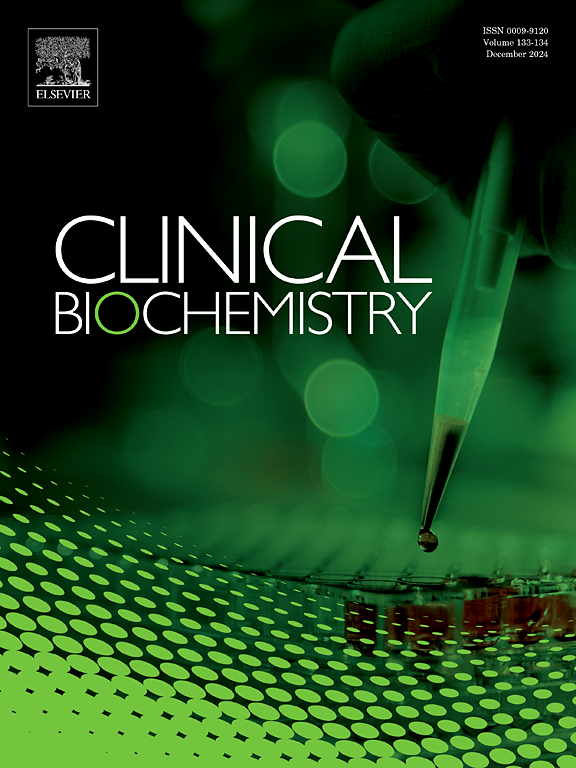Assessment of structural and functional characteristics of HDL and LDL in lung cancer patients in order to elucidate mechanisms of cholesterol metabolic pathways disorders
IF 2.1
3区 医学
Q2 MEDICAL LABORATORY TECHNOLOGY
引用次数: 0
Abstract
Introduction
Cholesterol metabolism dysregulation is recognized as one of the hallmarks of the cancer with highest mortality rate and the second most common malignancy – lung cancer (LC). LDL and HDL particles, the latter being carriers of the antioxidant paraoxonase-1 (PON1), were already proven to be altered in cancer patients. We have tried to investigate in more depth the cholesterol metabolism perturbances in LC, by analzying content of each of the LDL and HDL subclass and (anti)oxidative activity of each of the HDL subclass separately.
Materials and Methods
LDL and HDL subclasses from blood samples of 89 LC patients and 84 healthy subjects were separated and HDL subclasses PON1 activity assessed using Rainwater method and Gugliucci’s zymogram method, respectively.
Results
LC patients had higher relative proportion of HDL 2 particles, lower proportion of HDL 3 particles, and significantly lower activity of PON1 compared to control group (CG). Relative proportion of PON1 activity was higher on HDL 2b fraction and lower on all HDL 3 fractions of LC patients compared to CG. Relative proportions of LDL I and LDL II particles were increased, while proportions of LDL IV and small dense LDL particles were decreased in LC patients. Relative proportions of HDL and LDL subfractions and PON1 activities on HDL subfractions were found to be dependent on LC type and size, number of comorbidities and sites of progression, and overall response to therapy.
Conclusion
PON1 activity and lipoprotein subfractions distribution seem to be indicators of possible metabolic pathways (disorders) in LC.
评估肺癌患者HDL和LDL的结构和功能特征,以阐明胆固醇代谢途径紊乱的机制
胆固醇代谢失调被认为是死亡率最高的癌症和第二常见的恶性肿瘤-肺癌(LC)的标志之一。低密度脂蛋白和高密度脂蛋白颗粒,后者是抗氧化剂对氧磷酶-1 (PON1)的载体,已被证明在癌症患者中发生改变。我们试图通过分析LDL和HDL各亚类的含量以及HDL各亚类的抗氧化活性来更深入地研究LC中胆固醇代谢的扰动。材料与方法从89例LC患者和84例健康者的血液样本中分离sldl和HDL亚类,分别用Rainwater法和Gugliucci’s酶谱法评估HDL亚类PON1活性。结果与对照组(CG)相比,slc患者HDL - 2颗粒相对比例较高,HDL - 3颗粒相对比例较低,PON1活性明显降低。与CG相比,LC患者HDL 2b部分PON1活性的相对比例较高,而所有HDL 3部分PON1活性的相对比例均较低。LC患者LDL I和LDL II颗粒的相对比例升高,LDL IV和小密度LDL颗粒的相对比例降低。研究发现,HDL和LDL亚组分的相对比例以及HDL亚组分上PON1的活性与LC类型和大小、合并症数量和进展部位以及对治疗的总体反应有关。结论pon1活性和脂蛋白亚组分分布可能是LC中可能的代谢途径(紊乱)的指标。
本文章由计算机程序翻译,如有差异,请以英文原文为准。
求助全文
约1分钟内获得全文
求助全文
来源期刊

Clinical biochemistry
医学-医学实验技术
CiteScore
5.10
自引率
0.00%
发文量
151
审稿时长
25 days
期刊介绍:
Clinical Biochemistry publishes articles relating to clinical chemistry, molecular biology and genetics, therapeutic drug monitoring and toxicology, laboratory immunology and laboratory medicine in general, with the focus on analytical and clinical investigation of laboratory tests in humans used for diagnosis, prognosis, treatment and therapy, and monitoring of disease.
 求助内容:
求助内容: 应助结果提醒方式:
应助结果提醒方式:


